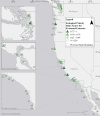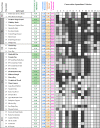Conservation aquaculture as a tool for imperiled marine species: Evaluation of opportunities and risks for Olympia oysters, Ostrea lurida
- PMID: 34153054
- PMCID: PMC8216563
- DOI: 10.1371/journal.pone.0252810
Conservation aquaculture as a tool for imperiled marine species: Evaluation of opportunities and risks for Olympia oysters, Ostrea lurida
Abstract
Conservation aquaculture is becoming an important tool to support the recovery of declining marine species and meet human needs. However, this tool comes with risks as well as rewards, which must be assessed to guide aquaculture activities and recovery efforts. Olympia oysters (Ostrea lurida) provide key ecosystem functions and services along the west coast of North America, but populations have declined to the point of local extinction in some estuaries. Here, we present a species-level, range-wide approach to strategically planning the use of aquaculture to promote recovery of Olympia oysters. We identified 12 benefits of culturing Olympia oysters, including identifying climate-resilient phenotypes that add diversity to growers' portfolios. We also identified 11 key risks, including potential negative ecological and genetic consequences associated with the transfer of hatchery-raised oysters into wild populations. Informed by these trade-offs, we identified ten priority estuaries where aquaculture is most likely to benefit Olympia oyster recovery. The two highest scoring estuaries have isolated populations with extreme recruitment limitation-issues that can be addressed via aquaculture if hatchery capacity is expanded in priority areas. By integrating social criteria, we evaluated which project types would likely meet the goals of local stakeholders in each estuary. Community restoration was most broadly suited to the priority areas, with limited commercial aquaculture and no current community harvest of the species, although this is a future stakeholder goal. The framework we developed to evaluate aquaculture as a tool to support species recovery is transferable to other systems and species globally; we provide a guide to prioritizing local knowledge and developing recommendations for implementation by using transparent criteria. Our collaborative process engaging diverse stakeholders including managers, scientists, Indigenous Tribal representatives, and shellfish growers can be used elsewhere to seek win-win opportunities to expand conservation aquaculture where benefits are maximized for both people and imperiled species.
Conflict of interest statement
While the following authors were affiliated with commercial companies - Gary Fleener, Hog Island Oyster Company; Gifford Pinchot IV, Chelsea Farms; and John Adams, Sound Fresh Clams and Oysters – they did not receive any salary support to contribute to the manuscript. This commercial affiliation does not alter their adherence to PLOS ONE policies on sharing data and materials.
Figures




References
-
- Angelini C, Altieri AH, Silliman BR, Bertness MD. Interactions among foundation species and their consequences for community organization, biodiversity, and conservation. BioScience. 2011. Oct 1;61(10): 782–789.
-
- Mcleod E, Chmura GL, Bouillon S, Salm R, Bjork M, Duarte CM, et al.. A blueprint for blue carbon: toward an improved understanding of the role of vegetated coastal habitats in sequestering CO2. Front Ecol Environ. 2011. Dec;9(10): 552–560.
Publication types
MeSH terms
LinkOut - more resources
Full Text Sources
Miscellaneous

